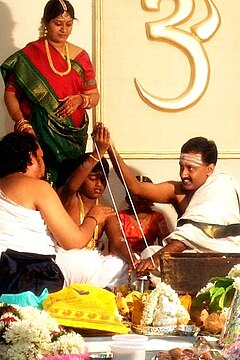naathamunikaL aruLich cheythathu taniiyan
gurumuha manadheethya praaHa vEdhaana @sEshaan^
narapathi parikluptham @soolka maadhaathu kaama:
@sva@sura mamaravandhyam raNGgan^aathaSya Saakshaath
dhvijakulathilakamtham vishNuchiththam namaami||
paaNdiya pattar aruLich cheythavai
minnaar thadamathiL soozh villipuththoor enRu oruhaal*
sonnaar kazhaRkamalam soodinOm* - munnaaL
kizhiyaRuththaan enRuraiththOm keezhmaiyiniRchErum*
vazhiyaRuththOm neNYjamE! vandhu
paaNdiyan koNdaadap pattar piraan vandhaan enRu*
eeNdiya shankam eduththoodha* - vENdiya
vEdhaNGgaL Odhi viraindhu kizhiyaRuththaan*
paathaNGgaL yaamudaiya paRRu.
periyaazhvaar thiruvadikaLE charaNam.
sri:
srimadhE raamaan^ujaaya nama:
periyaazhvaar aruLichcheydha
thiruppallaaNdu----------------translati
1: Many years, many years, many thousands of years and many hundred thousands more. Gem-hued Lord with mighty wrestling shoulders, your red lotus feet are our refuge.
2: To the bond between us, many and many a thousand years. To the dainty lady resting on your manly chest, many and many a thousand years. To the fiery orb discus adorning your right shoulder, many and many a thousand years. To the conch Panchajanya that strikes terror in the battlefield, many and many a thousand years.
3: You that stand and suffer life, come! Accept talc paste and fragrances. We shall not admit into our fold those who are slaves of the palate. For seven generations, pure hearted, we have sung the praises of Kodanda Rama who launched an army and destroyed Lanka, the demon's haunt.
4: Before you place your trust on infirm ground, come! Join us! O, Like-hearted man, give up your temporal aims and join us quickly! Let town and country resound with the chant 'Namo Narayanaya'. Ye Devotees, who wish to sing, come! Join us in singing Pallandu.
5: Asseting his supremacy over all creation, as Hrisikesha, he destroyed the clannish Asuras and Rakshasas. O Devotees, revere his feet, chanting the thousand names. Give up your old connections and ways and sing 'Many thousands of years Pallandu'.
6: my father's father's father's father and his grandfather before him, over seven generations have performed service to the Lord. In the asterism of sravanam, at dusk, the Lord came as the man-lion and tore apart the foe. End your suffering, join us! Sing 'Many years, many thousands of years Pallandu'.
7: Branded with a shape of the radiant discus blazing with the brilliance of fire we stands and serve, generation after generation. For him who swirled the discus over Banasura-- who was waging a war of illusion,-and made his thousand shoulders bleed, we sing Pallandu.
8: The Lord gives me good rice food with Ghee, and privileges of attendance, Betel leaf and Areca nut, ornaments for the neck and ears and fragrant Sandal paste to smear. He purges my soul. He has the Garuda bird,-foe of the hooded snakes, - on his banner; for him I sing Pallandu.
9: we wear the yellow vestments you wear and discard. We eat the food offered to you. We wear the woven Tulasi flowers you wear and discard, and rejoice. Keeping watch over the ways of the world, you appeared in the asterism of Sravanam. O Lord reclining on the hooded snake,To you we sing Pallandu.
10: My Lord! The day we became your bonded serfs, that very day our entire clan found its refuge and salvation, see! You appeared on that auspicious day in Mathura city, destroyed Kamsa's arsenal and danced on the head of the five hooded snake, Pallandu to you.
11: My Lord Tirumal! Like the faultless chief of Kottiyur Selvanambi, a mountain of respectability, I am an old faithful servant of yours, Chanting Namo Narayanaya and other names in myriad ways with all my power, O Pure One, I sing Pallandu to you.
12: These words were uttered with love by Villiputtur's Vishnuchitta, wishing 'Pallandu' for the pure Lord, the large-hearted one, wielder of the Sarnga bow. Those who enjoy singing this surround the Lord at all times chanting 'Namo Narayanaya', for them too, this god year Pallandu.
Lyrics in any language can be obtained from prapatti.com









